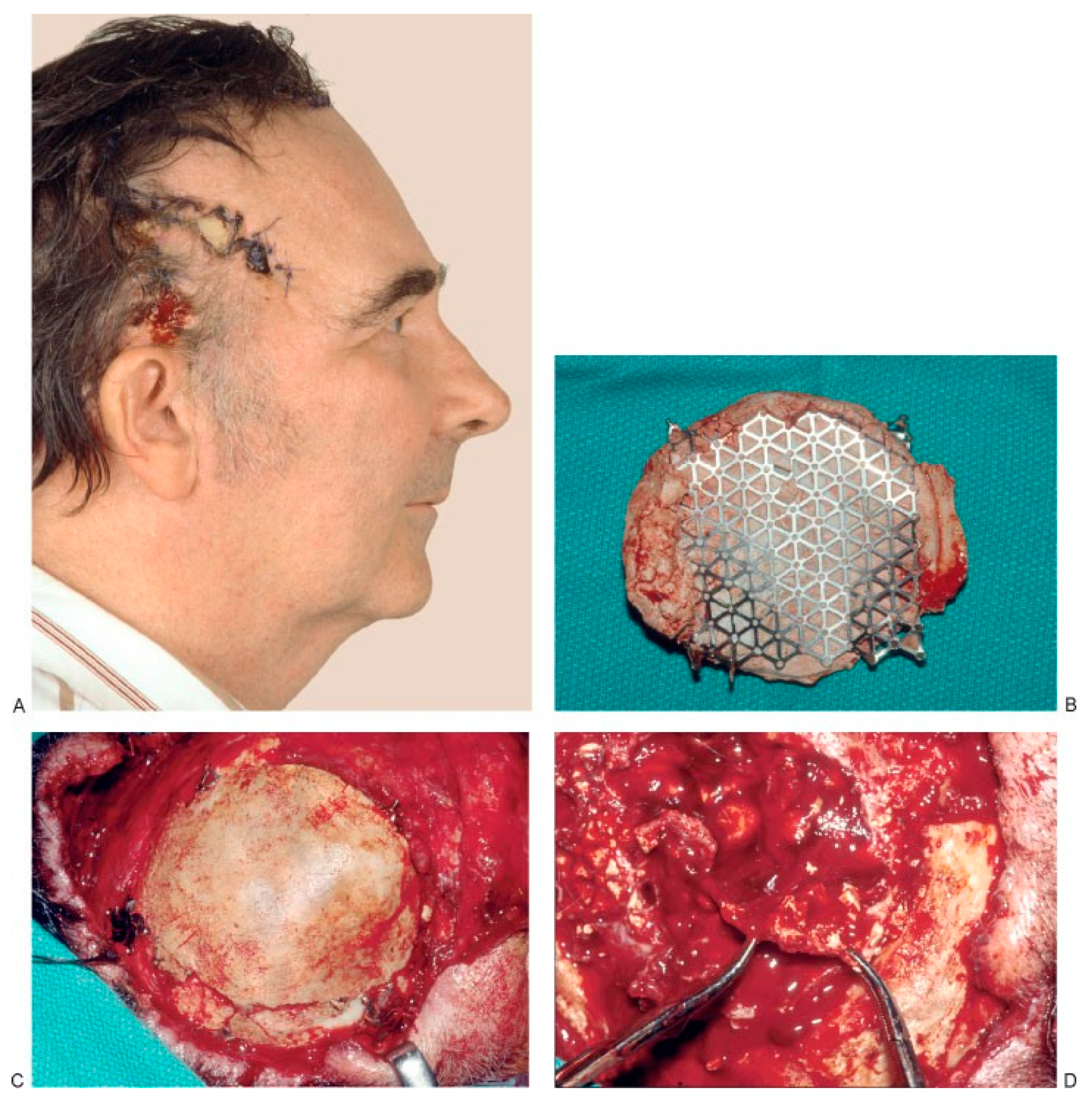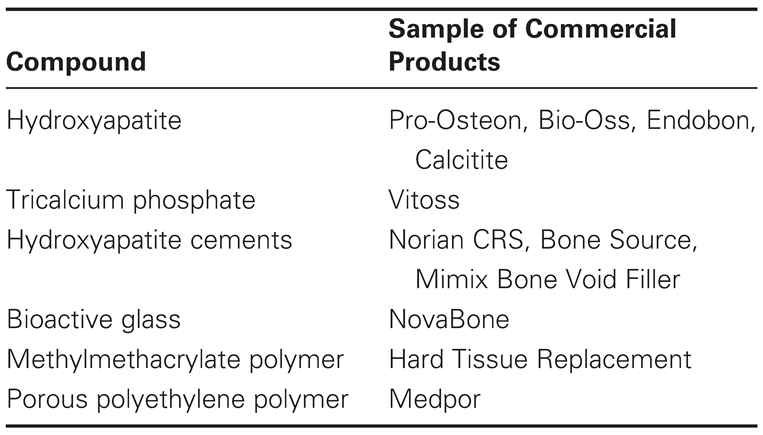Review of Bone Substitutes
Abstract
References
- Urist, M.R.; O’Conner, B.T.; Burwell, R.G. Bone Graft, Derivatives and Substitutes; Butterworth- Heinemann: Cambridge, UK, 1994. [Google Scholar]
- Flati, G.; Di Stanislao, C. Chirurgia nella preistoria. Parte I. Prov. Med. Aquil. 2004, 2, 8–11. [Google Scholar]
- Donati, D.; Zolezzi, C.; Tomba, P.; Vigano`, A. Bone grafting: historical and conceptual review, starting with an old manuscript by Vittorio Putti. Acta Orthop. 2007, 78, 19–25. [Google Scholar] [CrossRef]
- De Boer, H.H. The history of bone grafts. Clin. Orthop. Relat. Res. 1988, 226, 292–298. [Google Scholar] [CrossRef]
- von Walter, P. J. Chir. Und Augen-Heilkd. 1821, 2, 571.
- Schlickewie, W.; Schlickewie, C. The use of bone substitutes in the treatment of bone defects—the clinical view and history. Macromol. Symp. 2007, 253, 10–23. [Google Scholar] [CrossRef]
- Dressmann, H. Ueber Knochenplombierung bei Hohlenfor- migen Defekten des Knochens. Beitr. Klin. Chir. 1892, 9, 804–810. [Google Scholar]
- LeGeros, R.Z. Properties of osteoconductive biomaterials: calcium phosphates. Clin. Orthop. Relat. Res. 2002, 395, 81–98. [Google Scholar] [CrossRef]
- Gibson, I.R.; Bonfield, W. Novel synthesis and characterization of an AB-type carbonate-substituted hydroxyapatite. J. Biomed. Mater. Res. 2002, 59, 697–708. [Google Scholar] [CrossRef]
- FDA. Services, H., Ed.; Pre-Market Approval for Norian SRS Cement (PMA P970010); FDA: Silver Spring, MD, USA, 1998. [Google Scholar]
- Zins, J.E.; Moreira-Gonzalez, A.; Parikh, A.; Arslan, E.; Bauer, T.; Siemionow, M. Biomechanical and histologic evaluation of the Norian craniofacial repair system and Norian Craniofacial Repair System Fast Set Putty in the long-term reconstruction of full-thickness skull defects in a sheep model. Plast. Reconstr. Surg. 2008, 121, 271e–282e. [Google Scholar] [CrossRef]
- FDA. Services, H., Ed.; Bone Source HAC Marketing Approval; FDA: Silver Spring, MD, USA, 2002. [Google Scholar]
- FDA. Services, H., Ed.; Mimix Bone Void Filler Marketing Approval; FDA: Silver Spring, MD, USA, 2002. [Google Scholar]
- Goebel, J.A.; Jacob, A. Use of Mimix hydroxyapatite bone cement for difficult ossicular reconstruction. Otolaryngol. Head Neck Surg. 2005, 132, 727–734. [Google Scholar] [CrossRef]
- Burstein, F.D.; Williams, J.K.; Hudgins, R.; et al. Hydroxyapatite cement in craniofacial reconstruction: experience in 150 patients. Plast. Reconstr. Surg. 2006, 118, 484–489. [Google Scholar] [CrossRef] [PubMed]
- Baker, S.B.; Weinzweig, J.; Kirschner, R.E.; Bartlett, S.P. Applications of a new carbonated calcium phosphate bone cement: early experience in pediatric and adult craniofacial reconstruction. Plast. Reconstr. Surg. 2002, 109, 1789–1796. [Google Scholar] [CrossRef] [PubMed]
- Go’mez, E.; Mart’ın, M.; Arias, J.; Carceller, F. Clinical applications of Norian SRS (calcium phosphate cement) in craniofacial reconstruction in children: our experience at Hospital La Paz since 2001. J Oral Maxillofac Surg 2005, 63, 8–14. [Google Scholar] [CrossRef] [PubMed]
- Verret, D.J.; Ducic, Y.; Oxford, L.; Smith, J. Hydroxyapatite cement in craniofacial reconstruction. Otolaryngol. Head Neck Surg. 2005, 133, 897–899. [Google Scholar] [CrossRef] [PubMed]
- Moreira-Gonzalez, A.; Jackson, I.T.; Miyawaki, T.; Barakat, K.; DiNick, V. Clinical outcome in cranioplasty: critical review in long-term follow-up. J. Craniofac Surg. 2003, 14, 144–153. [Google Scholar]
- Zins, J.E.; Moreira-Gonzalez, A.; Papay, F.A. Use of calcium- based bone cements in the repair of large, full-thickness cranial defects: a caution. Plast. Reconstr. Surg. 2007, 120, 1332–1342. [Google Scholar] [PubMed]
- Losee, J.E.; Karmacharya, J.; Gannon, F.H.; et al. Reconstruction of the immature craniofacial skeleton with a carbonated calcium phosphate bone cement: interaction with bioresorb- able mesh. J. Craniofac Surg. 2003, 14, 117–124. [Google Scholar] [CrossRef] [PubMed]
- Miller, L.; Guerra, A.B.; Bidros, R.S.; Trahan, C.; Baratta, R.; Metzinger, S.E. A comparison of resistance to fracture among four commercially available forms of hydroxyapatite cement. Ann. Plast. Surg. 2005, 55, 87–92. [Google Scholar] [CrossRef]
- Ducic, Y. Titanium mesh and hydroxyapatite cement cranioplasty: a report of 20 cases. J. Oral. Maxillofac. Surg. 2002, 60, 272–276. [Google Scholar]
- Cho, Y.R.; Gosain, A.K. Biomaterials in craniofacial recon- struction. Clin. Plast. Surg. 2002, 31, 377–385. [Google Scholar] [CrossRef]
- Kitsugi, T.; Yamamuro, T.; Kokubo, T. Bonding behavior of a glass-ceramic containing apatite and wollastonite in segmen- tal replacement of the rabbit tibia under load-bearing conditions. J. Bone Jt. Surg. Am. 1989, 71, 264–272. [Google Scholar] [CrossRef]
- Gosain, A. KPlastic Surgery Educational Foundation DATA Committee. Bioactive glass for bone replacement in cranio- maxillofacial reconstruction. Plast. Reconstr. Surg. 2004, 114, 590–593. [Google Scholar] [CrossRef] [PubMed]
- Virolainen, P.; Heikkila¨, J.; Yli-Urpo, A.; Vuorio, E.; Aro, H.T. Histomorphometric and molecular biologic comparison of bioactive glass granules and autogenous bone grafts in augmentation of bone defect healing. J. Biomed. Mater. Res. 1997, 35, 9–17. [Google Scholar] [CrossRef] [PubMed]
- FDA. Services, H., Ed.; NovaBoneAR Marketing Approval; FDA: Silver Spring, MD, USA, 2004. [Google Scholar]
- FDA. Services, H., Ed.; NovaBone Putty Marketing Approval; FDA: Silver Spring, MD, USA, 2006. [Google Scholar]
- Cordioli, G.; Mazzocco, C.; Schepers, E.; Brugnolo, E.; Majzoub, Z. Maxillary sinus floor augmentation using bioactive glass granules and autogenous bone with simultaneous implant placement. Clin. Histol. Find. Clin. Oral Implant. Res. 2001, 12, 270–278. [Google Scholar] [CrossRef]
- Tadjoedin, E.S.; de Lange, G.L.; Lyaruu, D.M.; Kuiper, L.; Burger, E.H. High concentrations of bioactive glass material (BioGran) vs. autogenous bone for sinus floor elevation. Clin. Oral Implant. Res. 2002, 13, 428–436. [Google Scholar] [CrossRef]
- Duskova, M.; Smahel, Z.; Vohradnik, M.; et al. Bioactive glass- ceramics in facial skeleton contouring. Aesthetic Plast. Surg. 2002, 26, 274–283. [Google Scholar] [CrossRef] [PubMed]
- Manson, P.N.; Crawley, W.A.; Hoopes, J.E. Frontal cranioplasty: risk factors and choice of cranial vault reconstructive material. Plast. Reconstr. Surg. 1986, 77, 888–904. [Google Scholar] [CrossRef] [PubMed]
- Eppley, B.L.; Kilgo, M.; Coleman, J.J.I.I.I. Cranial reconstruc- tion with computer-generated hard-tissue replacement patient-matched implants: indications, surgical technique, and long-term follow-up. Plast Reconstr Surg 2002, 109, 864–871. [Google Scholar] [CrossRef] [PubMed]
- Eppley, B.L.; Sadove, A.M.; German, R.Z. Evaluation of HTR polymer as a craniomaxillofacial graft material. Plast. Reconstr. Surg. 1990, 86, 1085–1092. [Google Scholar] [CrossRef]
- Eppley, B.L. Craniofacial reconstruction with computer- generated HTR patient-matched implants: use in primary bony tumor excision. J. Craniofac Surg. 2002, 13, 650–657. [Google Scholar] [CrossRef]
- Eppley, B.L. Biomechanical testing of alloplastic PMMA cranioplasty materials. J. Craniofac Surg. 2005, 16, 140–143. [Google Scholar] [PubMed]
- Yaremchuk, M.J. Facial skeletal reconstruction using porous polyethylene implants. Plast. Reconstr. Surg. 2003, 111, 1818–1827. [Google Scholar] [PubMed]
- Cenzi, R.; Farina, A.; Zuccarino, L.; Carinci, F. Clinical outcome of 285 Medpor grafts used for craniofacial reconstruction. J. Craniofac Surg. 2005, 16, 526–530. [Google Scholar] [CrossRef] [PubMed]
- Menderes, A.; Baytekin, C.; Topcu, A.; Yilmaz, M.; Barutcu, A. Craniofacial reconstruction with high-density porous poly- ethylene implants. J. Craniofac Surg. 2004, 15, 719–724. [Google Scholar] [PubMed]
- Chen, B.; Lin, H.; Zhao, Y.; et al. Activation of demineralized bone matrix by genetically engineered human bone morpho- genetic protein-2 with a collagen binding domain derived from von Willebrand factor propolypeptide. J. Biomed. Mater. Res. A 2007, 80, 428–434. [Google Scholar] [CrossRef] [PubMed]
- Clokie, C.M.; Sa’ndor, G.K. Reconstruction of 10 major mandibular defects using bioimplants containing BMP-7. J Can Dent Assoc 2008, 74, 67–72. [Google Scholar] [PubMed]
- Fu, Y.C.; Nie, H.; Ho, M.L.; Wang, C.K.; Wang, C.H. Optimized bone regeneration based on sustained release from three- dimensional fibrous PLGA/HAp composite scaffolds loaded with BMP-2. Biotechnol Bioeng 2008, 99, 996–1006. [Google Scholar]
- Chung, Y.I.; Ahn, K.M.; Jeon, S.H.; Lee, S.Y.; Lee, J.H.; Tae, G. Enhanced bone regeneration with BMP-2 loaded functional nanoparticle-hydrogel complex. J. Control Release 2007, 121, 91–99. [Google Scholar] [CrossRef] [PubMed]
- Hoshino, M.; Namikawa, T.; Kato, M.; Terai, H.; Taguchi, S.; Takaoka, K. Repair of bone defects in revision hip arthroplasty by implantation of a new bone-inducing material comprised of recombinant human BMP-2, Beta-TCP powder, and a biodegradable polymer: an experimental study in dogs. J. Orthop. Res. 2007, 25, 1042–1051. [Google Scholar] [PubMed]
- Murata, M.; Akazawa, T.; Tazaki, J.; et al. Blood permeability of a novel ceramic scaffold for bone morphogenetic protein-2. J. Biomed. Mater. Res. B Appl. Biomater. 2007, 81, 469–475. [Google Scholar] [CrossRef] [PubMed]
- Liu, H.W.; Chen, C.H.; Tsai, C.L.; Lin, I.H.; Hsiue, G.H. Heterobifunctional poly(ethylene glycol)-tethered bone mor- phogenetic protein-2-stimulated bone marrow mesenchymal stromal cell differentiation and osteogenesis. Tissue Eng. 2007, 13, 1113–1124. [Google Scholar] [CrossRef] [PubMed]
- Turhani, D.; Weissenbo¨ck, M.; Stein, E.; Wanschitz, F.; Ewers, R. Exogenous recombinant human BMP-2 has little initial effects on human osteoblastic cells cultured on collagen type I coated/noncoated hydroxyapatite ceramic granules. J. Oral. Maxillofac. Surg. 2007, 65, 485–493. [Google Scholar] [CrossRef] [PubMed]
- Okafuji, N.; Shimizu, T.; Watanabe, T.; et al. Tissue reaction to poly (lactic-co-glycolic acid) copolymer membrane in rhBMP used rabbit experimental mandibular reconstruction. Eur. J. Med. Res. 2006, 11, 394–396. [Google Scholar] [PubMed]
- Va¨lima¨ki, V.V.; Yrjans, J.J.; Vuorio, E.I.; Aro, H.T. Molecular biological evaluation of bioactive glass microspheres and adjunct bone morphogenetic protein 2 gene transfer in the enhancement of new bone formation. Tissue Eng. 2005, 11, 387–394. [Google Scholar] [CrossRef] [PubMed]
- Kim, C.S.; Kim, J.I.; Kim, J.; et al. Ectopic bone formation associated with recombinant human bone morphogenetic proteins-2 using absorbable collagen sponge and beta tricalcium phosphate as carriers. Biomaterials 2005, 26, 2501–2507. [Google Scholar] [CrossRef] [PubMed]
- Jensen, T.B.; Overgaard, S.; Lind, M.; et al. Osteogenic protein-1 increases the fixation of implants grafted with morcellised bone allograft and ProOsteon bone substitute: an exper- imental study in dogs. J. Bone Jt. Surg. Br. 2007, 89, 121–126. [Google Scholar] [CrossRef] [PubMed][Green Version]
- Elsalanty, M.E.; Por, Y.C.; Genecov, D.G.; et al. Recombinant human BMP-2 enhances the effects of materials used for reconstruction of large cranial defects. J. Oral. Maxillofac. Surg. 2008, 66, 277–285. [Google Scholar] [CrossRef]
- Anderson, J.M. The future of biomedical materials. J. Mater. Sci. Mater. Med. 2006, 17, 1025–1028. [Google Scholar] [CrossRef] [PubMed]








© 2008 by the author. The Author(s) 2008.
Share and Cite
Pryor, L.S.; Gage, E.; Langevin, C.-J.; Herrera, F.; Breithaupt, A.D.; Gordon, C.R.; Afifi, A.M.; Zins, J.E.; Meltzer, H.; Gosman, A.; et al. Review of Bone Substitutes. Craniomaxillofac. Trauma Reconstr. 2009, 2, 151-160. https://doi.org/10.1055/s-0029-1224777
Pryor LS, Gage E, Langevin C-J, Herrera F, Breithaupt AD, Gordon CR, Afifi AM, Zins JE, Meltzer H, Gosman A, et al. Review of Bone Substitutes. Craniomaxillofacial Trauma & Reconstruction. 2009; 2(3):151-160. https://doi.org/10.1055/s-0029-1224777
Chicago/Turabian StylePryor, Landon S., Earl Gage, Claude-Jean Langevin, Fernando Herrera, Andrew D. Breithaupt, Chad R. Gordon, Ahmed M. Afifi, James E. Zins, Hal Meltzer, Amanda Gosman, and et al. 2009. "Review of Bone Substitutes" Craniomaxillofacial Trauma & Reconstruction 2, no. 3: 151-160. https://doi.org/10.1055/s-0029-1224777
APA StylePryor, L. S., Gage, E., Langevin, C.-J., Herrera, F., Breithaupt, A. D., Gordon, C. R., Afifi, A. M., Zins, J. E., Meltzer, H., Gosman, A., Cohen, S. R., & Holmes, R. (2009). Review of Bone Substitutes. Craniomaxillofacial Trauma & Reconstruction, 2(3), 151-160. https://doi.org/10.1055/s-0029-1224777



